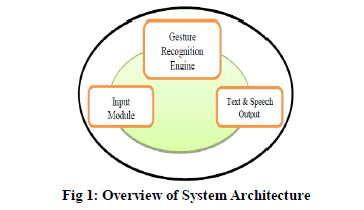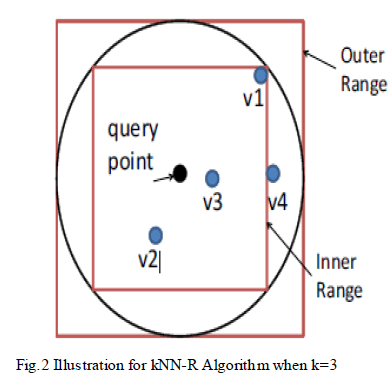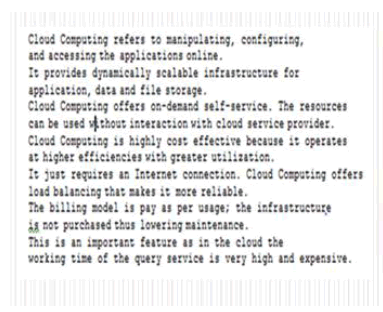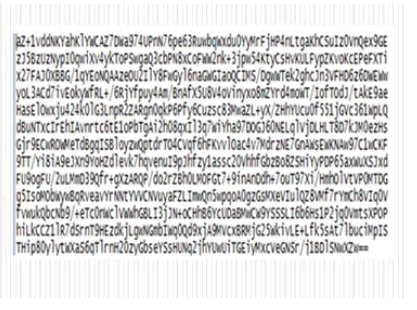ISSN ONLINE(2320-9801) PRINT (2320-9798)
ISSN ONLINE(2320-9801) PRINT (2320-9798)
| Reena D K* Final year M.Tech, Department of Computer Science, S.T.J.I.T. Ranebennur, Karnataka, India |
| Related article at Pubmed, Scholar Google |
Visit for more related articles at International Journal of Innovative Research in Computer and Communication Engineering
With the advent of cloud computing technology, using clouds for hosting data query service has become increasingly popular because of the low cost of computation, hosting applications and content storage. As in cloud the data management and infrastructure management is provided by third-party security and privacy are the biggest concern. Until and unless data confidentiality and secure query processing are guaranteed it is always a risk for the data owner to move the sensitive data to the cloud. Workload must be reduced to fully realize the benefits of cloud computing. Therefore to meet the above said requirements RASP method is proposed where RASP stands for Random Space Perturbation. This data perturbation technique ensures that the data is not d istorted and does not lead to a security breach by allowing users to ascertain key summary information. Cloud computing enables outsourcing the management of the data related to individuals and organizations to a service provider as the hardware cost and t he maintenance cost is less. RASP provides exclusive security features for hosting query services in the cloud by satisfying the CPEL criteria where CPEL stands for data Confidentiality, query Privacy, Efficient query processing and Low working cost .KNN-R algorithm is used to process the range query and the KNN query. Here users have been authorized by the randomly generated product key value provided by the admin after successful registration followed by activation by admin thus maintaining confidentiality. User queries are retrieved within a very short span of time. Also analysed how the RASP method provides confidentiality of data and increases the working process of query.
Keywords |
| query services in the cloud, low in-house processing, RASP perturbation, Range query, KNN query |
INTRODUCTION |
| Cloud computing refers to the manipulation, configuration and access of applications online providing dynamicallyscalable infrastructure for application, data and file storage. On-demand self-service is offered by cloud computing. It isnot mandatory to have interaction with the cloud service provider for the usage of resources. Cloud computing operatesat higher efficiencies with greater utilizat ion and is thus cost effective. Only Internet connection is required for it.Cloud computing becomes more reliable as it offers load balancing. Pay as per usage technique is followed by thebilling model. Maintenance is lowered as the infrastructure is not purchased. This is an important feature as in the cloudthe working time of the query services is very high and expensive. |
| Data Confidentiality and query Privacy have become the major concerns as the service provider might lose thecontrol over the data in the cloud. Adversaries such as curious service provider can possibly make a copy of thedatabase or secretly hears the user queries which may be difficult to detect and prevent in the cloud infrastructures.For the protection of data and query privacy there is a need for new methods in the cloud. But, if the new methodsprovide slow query processing than it will be not advantageous. The approach holds the CPEL criteria for submitting aquery in cloud. The CPEL criteria stands for Confidentiality of data, query Privacy, Efficient query processing and Lowworking cost. The complexity of constructing the query service becomes complex by this method. |
| Some related approaches have been developed to address some aspects of the problem. However, they do notsatisfactorily address all of these aspects. For example, to improve the privacy and security the crypto-index [4]approach puts heavy burden on the infrastructure. The Order Preserving Encryption (OPE) [1] is vulnerable todistribution based attacks. Use of cloaking boxes to protect the data objects and queries is followed in the new Casperapproach [4] which affects the efficiency of query processing and the in-house workload. |
| For the construction of query services in the cloud Random Space Perturbation (RASP) method is proposed. Here thequery is separated as the Range query and the KNN query. This method satisfies all the four CPEL criteria concepts.The transformation of the mult idimensional data is done with the combination of order preserving encryption,dimensionality expansion, random projection and random noise injection. |
| Data confidentiality is provided by the RASP method and its combination. It is mainly used to protect themultidimensional range of queries in secure manner and with efficient query processing. |
| The range query is used for retrieving the data’s stored in the database where range denotes some valuebetween upper and lower boundary |
| The kNN query denotes K-Nearest Neighbor query where K refers to the positive integer |
RELATED WORK |
| Here is the summarization about the study of the existing process.In (1) OPE represents Order Preserving Encryption is used for data that allows any comparison. And that comparisonwill be applied for the encrypted data; this will be done without decryption. It allows database indexes to be built overan encryption table. The drawback of this process is the encryption key is too large and implementation makes the timeand space overhead. A bucket-diffusion scheme was proposed to protect the access pattern which however has tosacrifice the precision of query results and thus increase the client’s cost of filtering the query result. In (4) privacypreserving mult i keyword search is based on the plain text search. In this the searching process will done by rankingprocess. The drawback of this concept is because of ranking process in-house processing time will be maximized. In (7)Crypto index method is vulnerable to attacks but the working system of the crypto index has many difficult processesto provide the secured encryption and security. In (9) the New Casper approach is used to protect data and query but theefficiency of the query process is affected. Distances-Recoverable Encryption (DRE) is the most intuitive method forpreserving the nearest neighbour relationship. Because of the exactly preserved distances many attacks can be appliedWong et al. suggest preserving dot products instead of distances to find kNN which is more resilient to distancetargetedattacks. One drawback is the search algorithm is limited to linear scan and no indexing method can be applied. |
PROPOSED ALGORITHM |
| a. kNN-R Algorithm: |
 |
| Above figure shows two rounds of communication between Client and Server. |
| b. Design Considerations |
| The query processing time is minimized to an extent. |
| User queries are answered in a short period i.e., 0.7 seconds |
| Only admin can activate the registered user and frequently checks his behavior and if found fraudulentpractices can deactivate the user. |
| Only with randomly generated product key provided by admin the user can access the cloud services thusdata Confidentiality is guaranteed. |
| Proposed Algorithm with description: |
| Aim of the proposed algorithm is reduce the query processing time thus providing data confidentiality. The queryprocessing finds the nearest k points in the square range that is centered at the query point. The proposed algorithm isconsists of three main steps. |
| Step 1: Finding the inner range by the Server: |
| The client will send the initial upper-bound range, which contains more than k points, and the initial lower-boundrange, which contains less than k points, to the server. The server finds the inner range and returns to the client. TheInner Range is the square range that contains at least k points, and the Outer Range encloses the square range thatencloses the inner range. |
| Step 2: Providing records in the Outer range to the client : |
| The outer range surely contains the kNN results but it may also contain irrelevant points that need to be filtered out.The client calculates the outer range based on the inner range and sends it back to the server. The server finds therecords in the outer range and sends them to the client. |
| Step 3: Finding top k candidates : |
| The client decrypts the records and finds the top k candidates as the final result. |
PSEUDO CODE |
| Step 1: The client generates the initial range and sends its secure form to the server. |
| Step 2: The server works on the secure range queries and finds the inner range covering at least k points. |
| Step 3: The client decodes the secure inner range from the server and extends it to the outer range, which is sent backto the server |
| Step 4: The server returns the points in the outer range |
| Step 5: The client decrypts the points and extracts the k nearest points. |
| Step 6: End. |
EXPERIMENTAL RESULTS |
| The experimental studies involve the kNN-R algorithm when k=3 as shown in Fig.2. The kNN-R algorithm providesdata confidentiality. There are at least k nearest neighbors to the query points with distances less than the radius r, asthe inner range contains at least k points. Therefore, the k nearest neighbors must lie in the outer range. Proposed kNNRalgorithm illustrates this procedure. Fig.3 shows that the authorized users can retrieve their queries either by Rangequery or kNN query. Because the user won’t know in advance about the result for the query that how many entries maycome as a result for the query so the range query is not usual. The query processing time is close to the upper bound0.7. Fig.5 shows the result of Advanced Encryption Standard (AES) algorithm for the text file in Fig.4. The proposedsystem uses AES algorithm for Encryption. The key consideration dealt in the proposal of implementing AESencryption for security over data that provides benefits of less memory consumption and less computation time ascompared to other algorithms. Though each cloud infrastructure has its own security strengths, the user can chooseinfrastructure according to security constraints. AES provide security to cloud consumers as encrypted data which issafe from many attacks .There are no serious weak keys in AES and it supports any block sizes and key sizes that aremultiples of 32 (greater than 128-bits). Statistical analysis of the cipher text has not been possible even after using hugenumber of test cases. No differential and linear cryptanalysis attacks have been yet proved on AES. |
 |
 |
 |
| Fig.4 Normal Text File algorithm. |
 |
| Fig.5 Same Text file stored in perturbed form in cloud after encryption by AES |
CONCLUSION AND FUTURE WORK |
| This project pursued the idea of using open source cloud namely DriveHQ as the storage of data submitted by the dataowner and the trusted party in a perturbed form. Upload speed can be many times faster in certain cases by usingDriveHQ magic upload technology. Before the files are uploaded to DriveHQ, they are encrypted locally. Thus it isextremely secure. Solut ions to certain top issues in cloud computing are provided by the proposed work. Firstly, lack ofsecurity which results in data being intentionally corrupted by the unauthorized disclosure of information. Secondly,slow query services in the cloud. Processing time of query is minimized to a larger extent. The data will be encryptedby Advanced Encryption Standard (AES) algorithm and stored in the cloud database to avoid original data loss . |
| The project is a feasibility study that aimed to explore the feasibility and potential for utilizing Cloudcapability to address data storage and processing needs. And can also continue studies to provide still betterperturbation approach and can improve the effect of the query by using real time cloud. |
References |
|